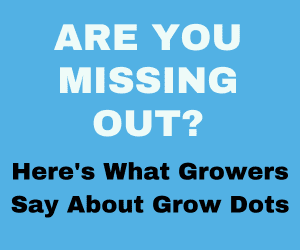Flushing is a broad term growers use for removing excess mineral nutrition from the media and plant near the end of its life. The idea behind flushing is to initially remove excess salts from the medium, letting the plant use up what has been stored over the course of its life. Instead of photosynthesis, the plant will use stored starches and carbohydrates for energy. I’ll go over organics and hydro. When to flush is not a set in stone formula based on some set amount of time. I base when and how to flush on the plant’s metabolism and growing style. I’ve found over the years longer flowering plants (10 or more weeks) seem to store more minerals in the bio mass for the long run and can need several weeks of plain water before the chop. While a plant that finishes in 7 to 8 weeks typically has a faster metabolism and may need just a week of plain water to use up what’s stored. Little new growth, swelling calyx, maturing pistols, and milky trichomes are an indication things are coming to an end.
Start of flush.

Day of chop.

I’ll go over organic growing in a living soil first. Organic growers don’t flush salts from their mediums because they don’t use them. They amend their medium with organic inputs initially like compost and then just add water, letting the biological life in the living soil provide nutrition to the plant when it asks. The most intimidating part of organic growing is getting started. Knowing how much of what input to use in your soil mix can be frustrating for new growers. I prefer to mix my own because I’ve never been happy with anything store bought. I’m a control freak even when growing organically. I basically don’t want certain minerals available in the medium being released when the plant is finished. No amount of water is going to rinse out minerals from organic matter. How much of what amendment can depend on what cultivar you choose, container size, finished plant size, etc. There are many factors to consider. A super soil requires more thought than permaculture or living soils. You can throw your soil out of balance easy by adding too much of this or that to a super soil mix. Start with someone’s proven formula the first few grows to learn all the variables your plant prefers tweaking the mix each time until you’re happy. A good living soil will not allow your plant to over consume minerals like a human force feeding 2000 ppm of salts in an oxygenated solution onto the roots on purpose or accident. Near the end of a plant’s life a sort of feed back loop begins. The plant stops feeding the microbes so in turn the microbes stop feeding the plant. This is known as the senescence or ripening stage. The term flushing has been around a long time and it’s not really the best way to describe the plant’s ripening and senescence phase. It helps to understand what’s going on at this time within the plant. Recognizing when the ripening stage has started comes with experience. This is where not knowing what your doing can stress your plants by trying to strip out everything. As a plant starts the senescence phase, it’ll slowly stop forming new stem and leaf. The bulking stage means the calyx are swelling. It doesn’t take as much energy to swell a calyx as it does to form leaf and stem. Even the bulk of the trichomes should be formed by now. Trichomes don’t form clear and turn milky over night. It takes time for the molecules in the trichome to form and convert.
As a plant starts to ripen, photosynthesis slows to a crawl. The plant has little need for much nutrition and will use up what’s been stored. During this senescence phase, microbes like bacteria will begin to leave the rhizosphere when photosynthesis slows causing fewer sugars to be exuded from the roots to feed them. Mobile minerals will be translocated up the plant causing older fan leaves to yellow and eventually fall off. Now with even fewer leaves, photosynthesis slows further creating even fewer sugars. This loop will continue until there are very few microbes left to feed the plant and the end result will be a smooth smoke. In hydro, flushing is a multi step process. You flush the medium of all or most of the mineral salts and then wait for the plant to use up whats stored. Using fulvic acid will greatly decrease the amount of water needed to remove excess salts. I like to think of feeding a plant like a roller coaster. The ride slowly creeps up like your ppm, peaks, then slowly descends for a second until it drops off. Healthy green plants have a high enough brix level to keep the train going until the end. Some semi-mobile minerals are still needed like calcium and other trace elements. These will help with enzyme and protein production to help the secondary metabolites like trichomes mature through chemical reactions. How you’re providing nutrition to your plant will depend on how to best help the plant finish without stress. A living soil will provide the necessary nutrition based on what the plant’s asking for until the end. The ratio and amount of each element needed does change quite a bit during the ripening stage though. Happy growing DGC and growers <3.







Yes I’m organic and flush. What about flushing after or right at week 3 of flower to move out nitrogen and flush with phosphorus to bring it in?
Good question J.R. In your situation I’d say kinda. Using NFTG is technically hydro. You don’t have feather meal, bone meal, blood meal, etc. in a bottle. You have whats derived from organic inputs in a bottle through chelates. Big difference. This means your mineral nutrition is bio-available without the need for any further breakdown of the inputs to be available. The components that make up your medium and it’s ability to hold minerals will play a factor. If you had sources of N like from blood meal in a granular form in the medium for example, it would be impossible to flush out the N.
Thanks bro. This was very helpful and informative.
In a drain to waste , coco / peatmoss , salt based fergitation situation would you recommend the flush at 3 weeks like in jr.s question ? I haven’t been flushing mid flower but do run into some hiccups around week 5. Was wondering if maybe that would help.
Also would a flush consisting of 100 ppm calcium and humic acid be good or should base nutes be included ?
Most mid-flower hiccups come from salt build up causing pH swings in the media. Over feeding is the cause. Best solution is to lower the concentration. Different formulas with different buffers is why some nutrient lines are harder to manage than others. Rinsing involves using as low ppm of minerals in water as possible. Humic and fulvic acids can help pull excess nutrition and salts from the media. You don’t “flush” with minerals like calcium and what not in this situation. Quality coco is buffered and rinsed of sodium with calcium nitrate but that’s a different situation.
Thanks man. I will lower my concentration. I feed low ( 750 ppm ) on average but agree that i see signs of over fertilization , and my ph 100 % raises alongside my mid flower hiccups. Also can low humidy play a role ? Mine sits around 30 %. 79 ° room hps.
Do you see any need for a 10/10 pk boost in my situation ? If so what week or weeks do you use them ? I read in one of your article if my mediums ph is 6.5 then my bloom booster is virtually useless. When i add it things get worse not better. I lower my base nutes and add in a small amount keeping the ppms at 750 or so. In week 6-7.
If your into odd grow problems. I had an airstone and pump in my res, it was leaving dark buildup on the bottom and raising my ph. I didnt realize because i wouldnt check a day later after the air stone did its thing. I removed the air pump and circulation pump and stir by hand now. Ph stays a lot more even …. im so lost as to why?
Co2 and calcium mixing from the air stone? And how do hand watering gardeners maintain their res?
Could that period of high ph and what ever that build up be the source of my problems?
First and foremost is the environment. 79 F with 30% RH is far too low and stressful. 50% RH at that temp is ideal. Most cloned genetics will do fine with a veg formula between 500-600 ppm for the first few weeks. Week 1, 500, week 2 550, week 3 600, etc. Depending on genetics, about half way through flower is considered peak flower production. This is the time when your concentrations are the highest. 8 week finishing time will peak between weeks 4-5. 10 week finishing time is typically between weeks 5-6. Some plants depending on their size and root mass can handle concentrations around 1000-1100 ppm of a flower formula. This is where a pk boost come in. A 1000 ppm res would have about 600-800 ppm of base nutrition and about 300-400 ppm of a p/k supplement to end up around 1000 ppm. After the peak of bud setting, concentrations can lower back down to to something like 800 ppm, then 700, then 600, etc. An air stone is pointless unless your res has a low enough temp to hold more oxygen. 68 F is where the sweet spot seems to be for roots. You don’t really need to worry about CO2 mixing with minerals like calcium. CO2 mixed with H2O creates carbonic acid. This acid actually dissolves minerals like calcium carbonate (limestone). When you mix carbon dioxide and water, a sludge can form in a res because of aerobic oxidation of organic matter like sugars. Plant roots release sugar exudates to feed microbes even in hydro systems that end up in a recirculating res. Growers who hand water use only water or mix nutrients a few hours before feeding and don’t keep a res.
Good stuff Mystro ????
Great stuff. Thank you
I always enjoy ur stuff. Extremely easy to read, easy on the brain. And always go away learning something new! Thanks for sharing bro!
I had a similar question to JR. I’m using NFTG and flushing with Herc Harvest for the first flush..When should I stop the HH and just flush with water J ? Thnx bro ✌️
Shep, the whole point of “flushing” a medium is to remove minerals. Flushing is done with as low ppm water as possible. Adding liquid bone meal (minerals) is not flushing. I would stop using HH a week before the chop. HH is 0-10-0, so it has 10% phosphorous. NFTG is a calcium based line and you should never have an issue with your soil holding on to adequate amounts of calcium. A healthy and happy plant has enough stored minerals in the plant tissue to last the plant through the ripening stage.
Thanks for the breakdown Jmystro! I got a question about flushing hydro with cold water. Do you know anything about that?
I don’t see an issue with lowering res temps down to the low 60’s F (as well as lowering night time room temps) during the last 10 or so day’s to help bring out some more color. Too low could cause the plant to go into shock and shut down which could delay maturity.
Still monitoring comments after 7 months. Yea, that’s Jmystro. Keep it classy my friend. When I visit the keys in 17 I owe you girthy blunt.
MM 88 is a good place to smoke a blunt. 😉
Ty mystro. U are a huge help.
Learned a lot thanks mystro 🤘🏻
in soil do you think its best to flush a little at a time or force feed distilled water multiple gallons at a time? hopefully the way i phrased that makes sense.
many thanks for the write up
Thank you so much jmystro. You really broke that down well. I can see that i had basically every thing wrong lol there is so much information out there and i waste a lot of time money and effort following it. Your information is invaluable and i really think your in a league all of your own. I couldn’t possibly have more respect for the knowledge you lay down.
I hate mixing nutes every day … total bummer there lol was mixing 15 gals for 3 days worth trying to streamline my hand watering. 2 x a day gets almost militant with how much discipline is needed.
Nothing to add still unsure of RO water I presume the need to add some calcium and a little magnesium to this water is not necessary with my flower flush usually being nine days. So just trying to clear up pulling the handle on the Girls.
great read! I really like your description of how microbes react to the change in a plants feeding behavior to initiate senescence. So cool, thanks!
perfectly written.